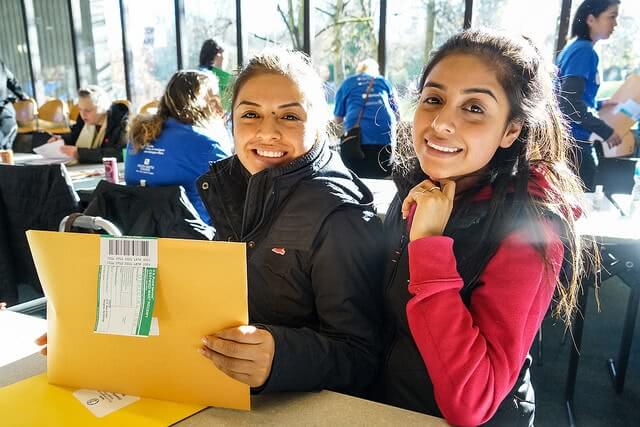Key Takeaways:
- Early Decision is a binding early application cycle.
- Early Action is also an early application cycle, but is not binding and students can generally wait until May 1 to make their decision.
- Both ED and EA are due Nov 1 or 15, but applicants should confirm by visiting the Colleges’ website.
Early decision and early action are early application cycles for students. Students interested in attending a specific school can use these application cycles to showcase their interest in the college. While early decision and early action are similar, they aren’t exactly the same. Here’s what you need to know about these application options, how they compare to one another, and how you can plan for submitting your applications.
Early Decision vs Early Action
While early decision and early action are similar, they have some key differences.
What is Early Decision?

Pixabay user Alexas_Foto
Early decision (or ED) is an early application cycle that is “binding.” This means, if a student applies to a school under the early decision banner, they’re expected to attend the following Fall.
Since early decision is considered binding, you’re only allowed to apply to one school at a time under early decision. You can apply to other schools through most early action processes or the regular decision cycle, but you can only apply to a single early decision school at a time. Applying to more than one could result in rejection letters from both if they find out – and schools do share lists.
If you’re accepted to an early decision school, you’re expected to withdraw all applications to other colleges and submit your deposit. After acceptance, if you find that you can’t afford the college after you’ve received financial aid award letters, you’re not obligated to attend.
If you’re rejected, deferred, or wait-listed, you’re welcome to apply to other colleges, including early decision II programs.

What is Early Action?
Early action or (EA) is another early application option, but unlike early decision, these applications aren’t binding. You don’t have to attend if you’re accepted and you usually have until May 1 to let the school know if you will be attending. It’s simply a way for students to express their specific interest in a college and get an early response, which makes it an ideal application process if you’re very interested in one school.
In most cases, you can apply to as many early action schools as you’d like. However, some colleges have started introducing “restrictive early action.” These ask that you only apply to one school under early action. As with early decision applications, applying to more than one school under restrictive early action can result in rejection letters from both schools.
When Are Early Decision and Early Action Applications Due?
Early decision and early action applications are usually due on November 1 or 15, with students hearing back by mid-December or January. However, deadlines can vary from school to school so always double check with colleges ahead of time. For example, Regis University requires early decision applications by October 1.
Some colleges also have early decision II, which generally has a due date of January 1 and students get responses around mid-February. This means, if you applied to a school under early decision in November and were rejected in December, you could technically apply to a school that offers early decision II in January.
Pros and Cons of Applying Through Early Decision and Early Action
There are a few advantages and disadvantages to applying through early decision and early action.
For the most part, they share the same advantages:
- You might only have to complete one application. If you apply to your dream school in November and get accepted in December, you won’t have to submit another application. However, you may want to apply to more anyway (if you didn’t apply under early decision) as this will give you the chance to compare financial aid offer letters.
- You receive an answer faster. Students applying under regular decision tend to wait two to three months for a response. EA and ED applications will hear back in a matter of weeks.
- You could have a higher chance of being accepted. EA and ED applicants are showcasing their specific interest in a college. Many schools take that into account, and early application cycles have higher acceptance rates than regular decision cycles.
- For early action, you don’t have to submit an answer until May 1. Early action isn’t binding, so you have months to decide if you’d like to attend (usually by May 1, though this can vary).
Some of the disadvantages of applying under these application cycles include:
- You have to complete your application sooner. An earlier application due date means completing your application faster. You’ll need to make a plan for letters of recommendation and your essay.
- The applications only pull from junior year, not senior year. If your GPA is going up in your senior year, EA and ED schools won’t be able to see your grades. They’ll be pulling from your junior year. However, early decision II cycles do look at your first semester of senior year.
- The application pool could be stronger. Most students aren’t applying early. The ones who do are very interested in the school and it could mean you’re up against some stiff competition.
- For early decisions, you can’t compare financial aid offers. Once you’re accepted to an early decision school, you’re expected to attend. Even if they offered you enough money to attend, you won’t be able to compare financial aid offers with other colleges.
Checklist for Early Decision and Early Action Applications
In order to increase your chances of getting your EA or ED applications in on time and improving your admission chances, make sure to complete this checklist:
1. Know the Due Dates for Applications
It’s important to know the due date of each school you’re applying to. While most schools have EA or ED deadlines by November 1 or 15 (and January for EDII), this isn’t a hard and fast rule. Many schools require these applications by October or allow you to submit them into December.
You also don’t want to wait until the last minute to turn in your applications as you could run into technical problems.
2. Start Early
You don’t want to wait until the last minute to turn in your applications as you could run into technical problems or issues completing specific parts of your application. The earlier you start, the better. If you find out it’s coming down to the wire and your application isn’t ready, you might want to consider delaying your submission to EDII or regular decision. You don’t want your admission chances to be hurt by an incomplete application.
3. Gather Letters of Recommendation
Once you know how many letters of recommendation you need, start asking your teachers and mentors to write them. Ask them as soon as possible so you’re giving them plenty of time to complete it. You may also want to tell them an earlier due date than you need to give yourself extra time in case they forget to write them.
Make sure to also ask for enough copies and then some. You will want enough for all your applications and then a few extras in case you have to apply under regular decision.
4. Complete the Applications
The most obvious part of the college application is the “application” itself. This is where you put your name, address, school information, list your extracurriculars, and more.
You’ll also have to submit your official high school transcripts, so make sure you’re familiar with the process. If you’re not sure what to do, talk to your guidance counselor or college advisor ahead of time.
5. Write the Essay
A majority of college applications will require you to write an essay or ask you to submit a personal statement. These can be on very specific topics or be open ended. Always follow the directions, including required word counts, as missteps here could result in a rejection letter. Brainstorm topics, write, edit, and have someone else read over your work for feedback.
6. Take the ACT or SAT a Final Time
You may have to take your final ACT or SAT a bit earlier than other students to meet the Early Action or Early Decision deadlines. Schedule your test date ahead of time to secure your seat and start studying as soon as possible.
7. Complete FAFSA and Other Financial Aid Applications
You’ll absolutely want to complete the Free Application for Federal Student Aid (FAFSA) when it opens. While it usually becomes available on October 1, new forms and an updated website in recent years have pushed it back to December 1 for the 2025-26 application cycle.
You technically don’t have to complete it as soon as it opens, but delaying could result in you missing out on Pell Grants and institutional grant aid.
You may also want to or be required to complete the CSS Financial Aid Profile for some colleges you’re applying to. In addition, some states require you to complete state financial aid applications in order to be eligible for their scholarships and grants.
Should You Apply to Other Schools After Submitting an Early Application?
In most cases, yes, you should start on other college applications after you submit an early application under early decision or early action. While schools will get back to you in just a few weeks about your acceptance, you could be pressed for time if you receive a rejection letter.
For example, if you hear back from a college that you weren’t accepted on December 15 and another college you’re interested in requires regular decision applications on January 1, you only have a matter of weeks – over the holidays – to submit your forms. This could hinder your acceptance chances.
While restrictive early action and early decision do request that you only apply to a single school under early action or early decision, it doesn’t mean you’re completely barred from applying to other colleges.
- For early decision and early decision II, you can to apply to colleges under early action and regular decision as long as you haven’t yet been accepted to that early decision school.
- For restrictive early action, you can apply to other schools under regular decision.
- For early action, you can apply to as many early action or regular decision schools as you’d like, or to a single early decision college.
Weighing Your Options
Deciding to “wait and see” with your early applications can put you in a stressful situation if you’re deferred or rejected to a specific college. Even if you just get a head start on your applications but don’t submit them until you hear back from your EA or ED school, you can save yourself from a lot of worry in the coming weeks.
Applying under early decision or early action isn’t something you should take lightly. It shows commitment and sincere interest in the college, and requires a lot of extra work from you during an already busy senior year. If you do decide to apply early, make sure you have your ducks in a row to increase your chances of getting accepted to your dream school.
Did you know that College Raptor can help you explore your acceptance chances? College Match helps you find schools that match your achievements, test scores, and preferences. Sign up today for free.





